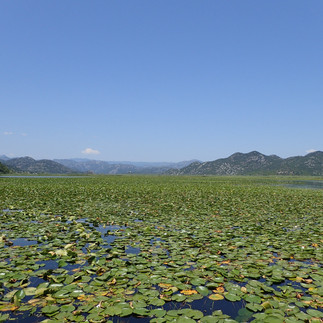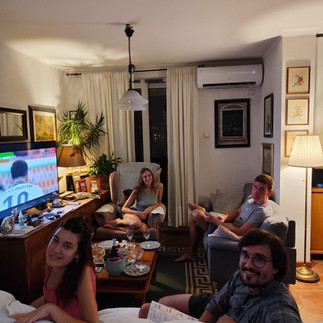Montenegro
- Kathleen Marko
- Jul 19, 2024
- 5 min read
We land in Podgorica with a one-night stopover en route to Kotor. It’s one of the smallest airports I’ve ever been to. They’re quite literally using farm equipment as some of their airport machinery. I love the Balkans. I order a car to our hostel, and in stark contrast to what we just saw, we are picked up in a brand new Tesla.
We arrive at the hostel hoping for just a comfortable bed. Immediately we are greeted at the check-in desk by a Mexican lady and her two Brazilian friends. Global diaspora is not what I expected of little old Podgorica. I later learn Montenegro is a common spot to wait out the pesky 90-day Schengen visa rule. The Q Podgorica turns out to be a little gem, sadly overlooked as a stopover on peoples’ journeys onwards. It’s full of quirky decor and cool people.
We too are just passing through, and on we go to Kotor, the first stop on our trip where we will see my family. The classic pre-war Yugoslav story-oneness and opportunity-spread us across more than half the former republics. My dad’s cousin Barbara awaits us at the bus station and immediately takes us to a homemade lunch of eggplant, prosciutto, and pomadoro. It’s all amazing and much-needed after dinners of frozen veggies cooked in instant noodles. We go for a post-lunch swim in the sea with Barbara and Slobo and return later for dinner. You have better packed your appetite, because grandma Tilda is watching and topping off your plate!
To our luck, Barbara works in local government and tourism, so we have a special program planned just for us, complete with family dinners and as many must-see spots around Kotor as possible. We relish in views of the bay from our terrace and the ability to do our laundry in a washing machine instead of a sink!
The next day we take the cable car to the mountains above the city, Lovćen. It’s the pride and joy of Montenegro and at one point was displayed on the crest of the republic. Watching over from another summit, we also visit the imposing stone moseleum of King Njegoša. Hailing from a village nearby, he came to rule these lands not with violence but diplomacy. My cousin Una tells us he traveled widely and is quite the scholar, having several of his own writings still preserved. From his perch the whole country seems tiny. I can see the sea, Podgorica, Albania, and I’m told even Bosnia and Italy on a clear day in my 360 degree view.
We head back to town down a winding, single-lane road with sheer cliffs on both sides. The beautiful bay glistens between the mountains of the only fjord in Southern Europe. Until it’s blocked out by a bus coming the other way. Here the laws of the road are governed by physics rather than safety or traffic optimization. After a quick puzzle, we squeeze 6 cars around the bus and are on our way again.
We’ve now seen the whole town from above, it’s time to see it from below. With fortifications dating back a millennium, the current form of the town is largely as it was since Venetians controlled the area. The entire coast of Croatia and this bay have changed hands countless times, being a strategic port for trade. Locals were quick to adapt to change, taking pride in being from Kotor rather than whichever empire ruled at the time. The only rule which stood was that so long as no citizens from Kotor were sent to fight in a foreign power’s war then there would be no conflict.
We cross a stone bridge and pass through the old walls encircling the town. It looks like something from a movie. Cobble stone streets, stone buildings packed in like sardines. From above it looks small, hardly more than a New York City block. Inside, we wander mazes of back alleys for an hour without retracing our steps. We climb the walls and see moats and draw bridges. No wonder this city has remained intact so long.
In fact, it seems the largest change to the city has not been war, conquest, or even a devastating earthquake in the 80s. Rather it’s been tourism. The city bustles with young Brits filing out of hostels to pubs and discotheques.
It’s been a long day so we head to bed to get ready for an even more ambitious assault on the city. Bright and early…okay maybe 10:30 AM. We arrive to the city walls ready to storm the castle at the top of the hill, several thousand steps up. We are quickly reminded why this place lasted as long as it has. I’m certain that the climb alone would have killed me if I were wearing anything more than short shorts and a t shirt. The view is sweeping but pales in comparison to those from the prior day. At least we got a workout.
Refuel at Barbara’s with mouth-watering punjene paprike, a sunset swim in the bay, and we’re ready to see my dad’s other cousin Andrej. A cargo ship captain, we got lucky that he was home this time between months-long stints at sea. We get pizza (our first of the trip!) in Perast with his wife and more cousins, while hearing local legends of pirates and sailors. The food is delicious, and the town is grand. We learn it was once home of wealthy traders who had boat docks underneath their seaside villas.
The only thing more opulent is the town of Puerto Montenegro we pass through after. Playground of international billionaires. Its claim to fame is being the only dock suitable for multiple mega yachts in the Adriatic.
Our last day is spent with Barbara and Una birding and boating at the lily pad-laden Lake Skadar. It’s nice to be off our feet so long and in such a serene environment. As Kathleen points out by the time we get off the boat, it feels like we have been at the spa.
Once back in Kotor, we join the locals for one last swim. As the sun sets all around the city, people bob around off docks and old men discuss politics in their speedos. It’s a lifestyle that we hope is one day embraced wherever we live. We join Barbara, Una, and Boris for one final evening together watching the Euros before packing for the next leg.
Goodbye Montenegro and a special thanks to Barbara and her family for being especially amazing hosts! We hope to see you all soon!




































Comments